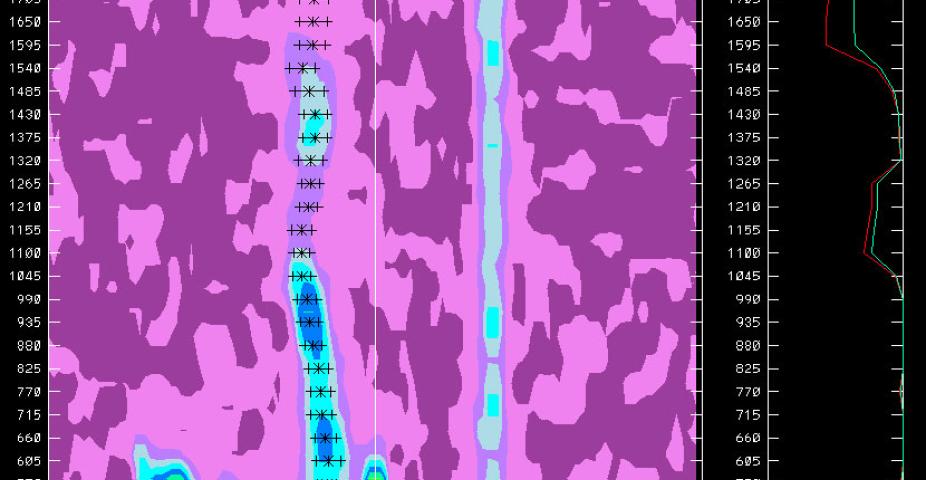Real-Time Four-Dimensional Data Assimilation (RT-FDDA)

The RT-FDDA system was developed to provide high-resolution analyses and short-term (0 – 12 h) forecasts, although recent advances in computing power enable longer outlooks to be generated. RT-FDDA employs a time-continuous assimilation of a variety of synoptic and asynoptic observation data to provide real-time local-scale analyses and short-term forecasts in a cycling fashion. The RT-FDDA is built upon a high-resolution MM5 numerical weather prediction model (future versions will be based on the WRF model) and the data assimilation makes use of a Newtonian relaxation (i.e., nudging) scheme. The characteristics of the RT-FDDA system generally contribute to superior analysis and forecasts compared to a twice daily MM5 forecast system, especially for shorter forecast lead times. The RT-FDDA system is used in a variety of both winter and summer weather hazard applications.
The RT-FDDA system was developed to provide high-resolution short-term analyses/forecasts (0-12 h). However, recent advances in computing power have allowed for a much longer forecast cycle; up to 36 h at current operational sites given the present grid and model physics configuration. In contrast, the twice-daily MM5 runs were specifically designed to provide long term forecasts (24-48 h).
RT-FDDA employs a time-continuous assimilation of a variety of synoptic and asynoptic observation data including:
- METAR observations (includes "Specials")
- MesoWest surface observations
- Ship/buoy observations
- Local surface observations
- NWS and site rawinsonde observations
- NOAA and site vertical profiler observations
- NESDIS satellite-derived winds
- ACARS data (within the next month)
These data sets have time frequencies varying from 5 min to 3 h, and are assimilated into the RT-FDDA system at their particular valid time.
By comparison, the twice-daily MM5 forecasts are limited to incorporating those observation data available at the synoptic times. These data are only used to improve the first guess at the initial time of the forecast cycle. Therefore, the twice-daily MM5 forecasts have a strong dependence on errors in the first guess. However, because the RT-FDDA cycles execute over a long period of time , errors can accumulate in regions without much data, although we have not observed major problems in this regard.
RT-FDDA analyses/forecasts do not generally suffer from model 'spin up' issues. Thus at any time, the RT-FDDA forecasts contain realistic and detailed mesoscale atmospheric structures, including cloud and precipitation systems, and local thermally-forced circulations. It should be noted that RT-FDDA does not assimilate cloud/precipitation data. The diagnosed cloud and precipitation systems in the analysis cycles result from the vertical motion and humidity assimilated from the available data.
The twice-daily MM5 forecasts, by comparison, are initialized using a 'cold start' methodology. This means that they start with no cloud and precipitation systems, or local thermally-driven circulations. Therefore, a certain amount of model 'spin up' time is required for the atmosphere, as it is represented by the MM5, to begin responding to the mesoscale forcing resulting from variations in the local complex physiography.
In summary, the characteristics of the RT-FDDA system generally contribute to a superior analysis/forecast compared to the twice daily MM5 forecast system. However, the advantages of RT-FDDA over the MM5 tend to decrease as the length of the forecast increases. This is principally due to the fact that the lateral boundary conditions employed by the MM5 and RT-FDDA systems are quite similar, and tend to have a stronger influence as the forecast length increases.
It is also worth noting that the RT-FDDA system performs 8 analysis/forecast cycles per day. Thus the WSMR and YPG RT-FDDA systems execute a 36 h forecast every three wall-clock hours, and the current DPG system executes a 12 h forecast in that same time frame. After the Olympics, DPG will receive a more powerful cluster, which will allow the execution of longer (~36 h) forecasts.
Lastly, the RT-FDDA system is temporarily employing a simple surface energy physics package. However, the RT-FDDA development team is busily working toward coupling Oregon State University land surface model (OSU LSM) to system.
Upgrade of the RTFDDA modeling at WSMR and YPG
The new system incorporates many recent research/test results by the NCAR RTFDDA developers. Some major improvements are listed as following:
- Land Surface Model (LSM): with more detailed and accurate soil physics than previous SLAB soil model.
- Increase of the vertical model level from 31 to 36 and keep the level-distribution density with height. In other words, the resolution is increased in all troposphere and with more improvement in PBL layer.
- An improved obs Quality_Control (QC) scheme that could effectively QC every kind of observations measured at any location, height and time. Previously only those obs that are located closed model 1st-guess levels were QC-ed.
- More strict QC constraints. Working together with 3), it makes the system high quality and reliability.
- Some bug fixes, including a correction of wind rotation from met to model projection (Some evident impacts on Domain 1).
- Adding new observations:
- ACARS: current only from UA aircrafts. We are working to get other airlines data also.
- NPN-profilers (30 in the central USA), hourly, 0.5-16km
- Boundary Layer Profilers (BLP) (~25, most of which are in California and other coastal states).